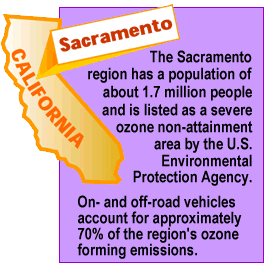Ozone levels depicted in Smog City are estimated by simulating the air quality over Sacramento, California using a computerized model of the region.The computer model creates an imaginary box over the area to represent the atmosphere above Sacramento. Air quality conditions in the box are simulated to account for both human influences and natural factors that affect ozone formation.
Each simulation represents one day. In the morning, the box has healthy air quality conditions. As each hour of the day passes, emissions from human activities, such as industry, cars, and trucks, and from natural sources like trees and plants, are injected into Smog City's atmosphere. Emissions take into account variations in human activity, such as morning rush-hour traffic. Emissions are then subjected to movement and mixing, which are influenced by weather characteristics such as wind speed, sunlight, and temperature.
18,000 model simulations were
run to develop Smog City's relationships between weather, population, emissions levels, and ozone.
The computer model takes these meteorological effects into account in determining the rate of chemical reactions that cause ozone levels to rise or fall. The model uses 85 chemical reactions and 30 different chemical compounds to simulate ozone formation.



